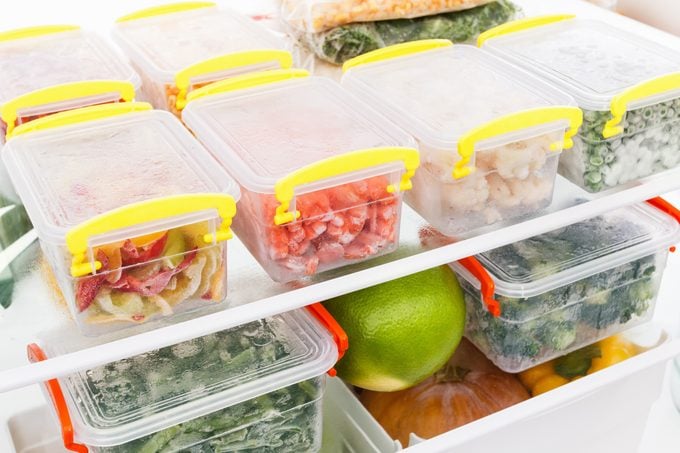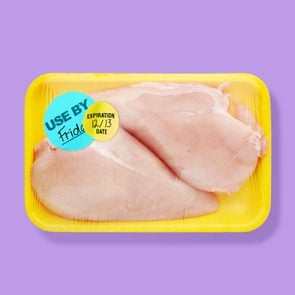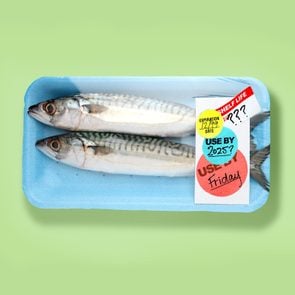How to Freeze Almost Every Type of Food
Updated: Aug. 02, 2023
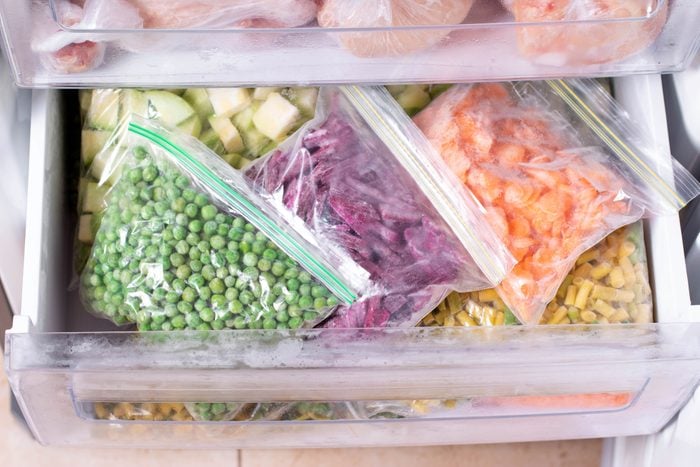
Your handy guide to freezing foods, from what you can freeze to how long they'll keep and more
Whether you’re trying to reduce food waste, save money by buying in bulk or figure out what to do with an overly generous edible gift, there’s a good chance you’ve taken to Google to ask, “Can you freeze this food?” Let’s face it: Even if your fridge organization is completely on point, there will always be days when it makes more sense to move that bread, produce or chicken stock to the freezer.
While the answer to any “Can you freeze it?” query is usually yes, there are steps you can take to ensure your frozen foods don’t lose their flavors or get freezer burn. (Step one: Learn how to organize a freezer effectively.) Much of the work comes from knowing how to cool, package and cook different foods to maintain maximum food quality. With that in mind, we asked experts to weigh in on exactly how to freeze almost every type of food. Follow these steps, and you’ll be saying goodbye to worries about sell-by dates and how long food lasts in the fridge.
Best practices for freezing food
Regardless of what food you’re putting in the freezer, keep the tips below in mind.
Avoid putting hot food in the freezer
“Ice is actually a great insulator, so in some cases, the outside of a food will freeze first and then the interior will stay warm for a long period of time, which can allow harmful bacteria to grow,” explains Natalie Seymour, MS, a food safety manager at Ecolab. To avoid this, make sure food is completely cooled before you pop it into the freezer. First, cool it to room temperature on the counter. Then let it reach fridge temperature in the refrigerator before freezing.
Don’t forget to label
“Our No. 1 rule is to label everything with the name of the dish and the date you’re freezing it,” says chef Ashley Christensen, who co-authored It’s Always Freezer Season with Kaitlyn Goalen. “We use colored masking tape and a Sharpie—affixed to the food before it’s frozen [otherwise, the tape won’t stick]. This might seem a little intense, but it’ll make sense in six months, when the dish you’ve pulled out of the freezer resembles nothing you’ve cooked in recent memory.”
Vacuum-seal food—if you can
“Since air exposure is the enemy of frozen food, vacuum-sealed packaging is the standard-bearer,” says Christensen.
Yes, the airtight nature of vacuum-sealed packaging makes it the ideal option for freezing food. But there’s a catch: It requires an investment in an additional countertop appliance, and you have to find a place to store it. Plus, you won’t be able to vacuum-seal large meals. “Most countertop vacuum-sealing appliances have a maximum width of 12 inches, which means you probably won’t be vacuum-sealing whole casseroles, pies or large loaves of bread,” she says.
If you are not vacuum-sealing, just be sure to select the right reusable or disposable container. One of the best options: zip-top plastic bags. “Honestly, these bags are one of the more important tools in our freezer arsenal,” Christensen says. “The downside, of course, is that they are single-use when you’re putting them in the freezer. But it’s hard to beat their utility, performance and convenience.” Make sure to use freezer-specific bags, which are more durable than regular ones.
Choose the right containers
If you are using rigid containers (like Tupperware), opt for those with straight sides as opposed to rounded edges. They’re much easier to stack and remove food from. If you are using glass containers (yep, you can put glass in the freezer!), choose ones with large lids or openings, and don’t pack the food in too tight—liquid expands in the freezer, so if there’s too much, your glass container might crack.
“Choosing the container is only half the equation. Just as important is choosing the lid or cover,” Christensen adds. “You want to package your food to be as airtight as possible for the best results. Lids with silicone gaskets or clips are particularly good at keeping air out.”
Portion appropriately
“When you’re getting ready to freeze something, think about how you want to use it later,” suggests Christensen. “Is it the type of item that you’ll need to thaw out in large quantities? Or is it a batch of individual items that you’d like to be able to pull separately rather than all together?”
Since freezing, thawing and then refreezing food is not ideal, make sure your food is properly portioned before you put it into the freezer.
Wrap food like a present
If you’re using a container without a lid, use a 360-degree wrap, says Christensen. This way, the plastic wrap is adhering to itself instead of the dish. “You want to pull enough plastic wrap so that if you set the dish on top of the layer of plastic, you’ll have enough on each side to wrap around and overlap in the middle. Then pull more wrap, lay it flat and do the same thing, but with the dish turned 90 degrees. This should create full coverage and a completely airtight seal.”
Can you freeze meat?
Not only can you freeze meat, but it’s also one of the easiest foods to pop into your freezer for another day. “Meat takes well to being frozen without major sacrifice in quality of flavor or texture. Freeze it raw or freeze it cooked; pretty much any kind of meat will hold up,” says Christensen.
Here are her easy-to-follow meat-storage guidelines for optimal food quality: Frozen ground meat, bacon and sausage will last three to four months. Frozen steaks and chops (beef or pork) are good for six to eight months. And frozen chicken parts will last nine months, while a whole chicken will last a year in the freezer.
Can you freeze dairy?
Everyone knows there’s at least one dairy product that tastes perfect when frozen: ice cream. But beyond your go-to summer treat, Christensen suggests sticking with hard cheeses and butter if you’re looking for diary items to store in the freezer.
“Freeze dense cheeses like cheddar, Gruyere and Parmigiano wrapped very tightly in plastic wrap or otherwise completely protected from oxygen, as cheese is particularly susceptible to freezer burn,” she says, adding that you should use your cheese within six months.
Butter, meanwhile, may be the dairy product best suited to freezing, so you don’t need to worry about tossing it if it nears its expiration date. “Not only does it retain all of its characteristics once thawed, but some chefs and food scientists even suggest storing it in the freezer is preferable to the refrigerator to keep it from growing rancid in higher-temperature environments.”
Just make sure your butter is wrapped tightly—it easily absorbs odors and flavors that may affect the taste once thawed—and use it within four months.
As for the dairy products that shouldn’t be frozen? “Liquid dairy, like milk, cream and buttermilk, will lose their viscosity and creamy texture if frozen and defrosted, instead forming jagged ice crystals,” Christensen says. The same goes for creamy soft cheeses like cottage cheese, cream cheese and ricotta, as well as sour cream and creamy sauces, which will separate or change texture with thawing as well.
Since you won’t be extending their shelf life in the freezer, you can cut down on food waste by knowing how long milk and other foods last past their sell-by dates. Take care to use them up in time.
Can you freeze fruits and vegetables?
When it comes to extending the shelf life of your produce, these fruit and vegetable storage tricks are a good place to start. And it doesn’t hurt to know which fruits and veggies to avoid storing together. But if you really want your produce to last, you’ll store it in the freezer. Just be sure you know which fruits and veggies handle freezing temps well—and which get limp and watery.
While you can freeze raw produce, Christensen recommends only doing so if you plan to cook them afterward. “When you’re freezing raw produce, the water in the cell walls turns to ice, making them mushy or droopy when thawed,” she explains.
Indeed, leafy greens like cabbage and lettuce will wilt and become limp, while water-rich veggies like celery, cucumbers and radishes will become water-logged and develop an unpleasant flavor. “However, you can freeze them, whole or chopped, if you plan to use them in recipes where you don’t need them in their crisp, raw state—think purees, sautés and casseroles,” Christensen adds.
Cooked produce, on the other hand, freezes beautifully, since the cell walls are already soft, as does blanched produce. (Blanching is quickly cooking produce in boiling water, then submerging it in ice water to halt the cooking process.) Blanching and shocking produce in an ice water bath also prevents the natural enzymes in fruits and vegetables from turning them brown in the freezer.
There are also some fruits and veggies that are best frozen in other forms. Avocados, for example, freeze adequately as a puree but not well whole or sliced. And if you’re freezing large mushrooms, you’ll want to slice or quarter them (instead of leaving them whole) before cooking. From there, you can freeze them.
As for the lifespan of frozen produce, Christensen says it depends on the item. Eat raw fruits, like berries, stone fruit, apples and pears, within nine months. Gobble up frozen raw bananas within six months or you’ll have to contend with freezer burn. Cooked greens will keep for about four months; cooked onions, beans and peas last six months; cooked sweet potatoes, eggplant and squash will last eight months; and chopped raw vegetables you intend to cook with can stay frozen for up to one year.
Can you freeze bread and grains?
Not only can you freeze bread and grains, but many grain- and nut-based products actually keep better in the freezer. “Keeping tree nuts, flours and grains in the freezer will protect against rancidity, which is especially likely to happen with fattier ingredients, such as nuts and nut flours,” explains Christensen. “If grains aren’t highly processed, they’re also more fragile, and keeping them in the freezer ensures a longer shelf life.”
The same goes for bread, which she recommends freezing after baking so as not to kill the yeast. Dough for pie crusts, biscuits and the like also freezes well, though cake batter does not.
Christensen suggests eating cooked rice and bread that’s been frozen within six months. Eat frozen baked goods, such as muffins, scones, biscuits and cakes, within two months. Raw dough and pie crust can stay in the freezer for much longer, up to nine months.
Can you freeze eggs?
“There’s some competing wisdom on freezing raw eggs,” admits Christensen. “If you try to freeze eggs in the shells, they’ll crack. You can freeze raw eggs out of the shell [by cracking them into a muffin pan or ice-cube tray, for example], which produces a noticeable, though not awful, effect on their texture.”
Instead, consider how long it is actually safe to eat expired eggs and how to tell if your eggs are still good before you revert to freezing them. Fact is, most of us toss our eggs before they’re truly bad. There’s a good chance your eggs will last in the fridge for longer than you think.
As for cooked egg dishes, like breakfast burritos or quiche, consider the type of egg you used before shoving leftovers in the freezer. “Cooked egg whites take on a strange, rubbery texture when frozen, but dishes in which eggs are beaten hold up quite well,” notes Christensen. These will keep for around three months.
Can you freeze fish and seafood?
Even though there’s plenty of vacuum-sealed fish in your grocery store’s freezer aisle, Seymour cautions against using this method at home. “There is a type of Clostridium botulinum—the bacteria responsible for botulism—present in some ocean waters. These bacteria will only produce their lethal toxin in environments without oxygen and at high enough temps,” she explains. “The frozen, vacuum-sealed fish you see in the store is frozen first and then vac sealed in special films, and then should be opened while thawing.”
Provided it is frozen safely, raw lean fish such as bass, cod, tuna and tilapia will keep for six to eight months, while raw shrimp will last four to six months and fatty fish like anchovies and sardines keep for three months. “Cooked fish has a slightly shorter freezer lifespan,” says Christensen. “Cooked shellfish will freeze well for three months and lean fish for four months. Cooked fatty fish should be eaten in six weeks.”
Can you freeze prepared foods?
Freezing prepared foods can drastically cut down on prep time on busy evenings while still ensuring you get a homemade meal on the table. The most important thing, says Christensen, is to let the food completely cool before packaging it and freezing it. As long as you do that, there are plenty of prepared foods that you can keep in your freezer. ”
Dairy-based soups, bread puddings, stratas and quiche are best eaten within three months,” Christensen says. “Meat-based soup, broth and pasta bakes are best within four to six months. And you have more time—about nine months—for vegetable-based soup.”
A few prepared foods you will want to avoid putting in the freezer: salads and sauces made with mayonnaise or vinaigrette, which will break down and change texture when frozen; fried foods, besides french fries and onion rings, which will get soggy; and casseroles with cheese or crumb toppings, which won’t have the cooked texture you’re looking for (though you can cook and freeze the casserole, then add the topping when you pop it in the oven to reheat).
Other prepared foods, such as tomato sauce and mashed potatoes, may need a quick blitz in the blender or the addition of some warm milk, respectively, to help them achieve their pre-frozen state after they’ve been thawed.
How to best thaw foods
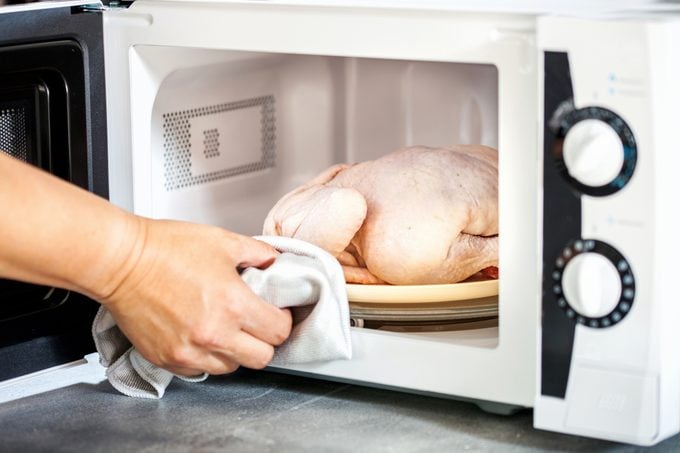
The key to thawing foods safely, explains Seymour, is considering how they are best stored before they were frozen. This will be the optimal thawing method, though all these methods will work for most foods. Here are the most common ways to thaw frozen foods.
In the fridge
“For items that need to be refrigerated, like meat, seafood, eggs and most dairy and cooked veggies, it’s best to thaw those in the fridge,” says Seymour. This method can take 24 hours or more but is the best way to avoid food reaching the temperature zone where bacteria can grow.
- Good for: Meat, seafood, dairy, eggs and cooked vegetables
- Thawing time: 24 hours
- Safety: This is the best choice for avoiding bacterial growth.
On the counter
“For foods that can be safely left at room temperature before freezing, like breads and produce, it’s fine to thaw these at room temperature,” Seymour says. This method may take a couple of hours.
- Good for: Bread and produce
- Thawing time: One to two hours
- Safety: Avoid thawing meat, seafood, eggs, dairy and prepared foods this way. It can lead to foodborne illness.
In cold water
It’s 30 to 60 minutes before dinnertime, and you’ve just realized one of your ingredients is frozen. You don’t have time to thaw it in the fridge, so cold running water is your best bet.
“Put your packaged ingredient into a larger bowl or vessel, or even a plugged sink, and run a slow, steady trickle of cold water over it until it thaws,” says Christensen. “While it’s way faster than thawing in the refrigerator, it isn’t exactly quick—expect 20 to 30 minutes for most items. Resist the urge to use hot water to speed it up.”
- Good for: Any frozen foods
- Thawing time: 20 to 30 minutes
- Safety: Avoid hot water, which will increase bacteria and your risk of foodborne illness. Make sure the food is in a leak-proof package or plastic bag while you run it underwater; a leaky bag could introduce bacteria.
In the microwave
Chefs may tell you not to touch your microwave’s defrost button, but for days when you are especially crunched for time, speed-thawing food in the microwave is an option. And the U.S. Department of Agriculture agrees it’s a safe option if you follow the best practices.
“Low power settings of the microwave or a short round in the Instant Pot [try two to three minutes], can speed things along,” Christensen says. “But proceed with caution—anytime you’re applying heat to frozen food in order to thaw it, you’re risking the chance its temperature will rise into the danger zone.”
- Good for: Quick thawing of most frozen foods
- Thawing time: 2 to 10 minutes, depending on the food
- Safety: Cook the food immediately after thawing to prevent bacterial overgrowth and illness.
Cooking from frozen
If your meat isn’t thawed all the way through when it’s time to begin cooking, that’s A-OK, says Seymour. “There is nothing wrong with cooking a frozen burger. It just takes a tad longer to get to the right temperature. And there’s nothing wrong with throwing frozen veggies into your soup while it’s simmering.”
The same goes for oven-baked dishes like lasagna or casseroles, though they will require a longer baking time. Aim to cook for 50% longer than the recommended time for the thawed food.
- Good for: No-fuss cooking of all frozen foods
- Thawing time: None
- Safety: It’s perfectly safe to cook foods without thawing.
Now that you’re a pro at freezing food, make sure your freezer is set to the right temperature.
Sources:
- Natalie Seymour, MS, food safety and audit development manager in global food retail at Ecolab
- Ashley Christensen, chef and co-author of It’s Always Freezer Season: How to Freeze Like a Chef with 100 Make-Ahead Recipes
- National Center for Home Food Preservation: “How Do I … Freeze?”
- USDA: “The Big Thaw: Safe Defrosting Methods”

